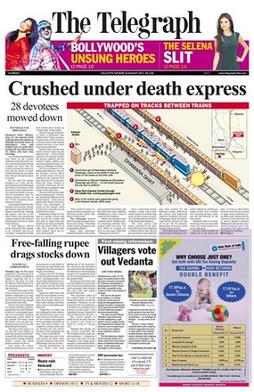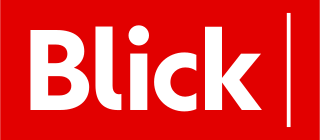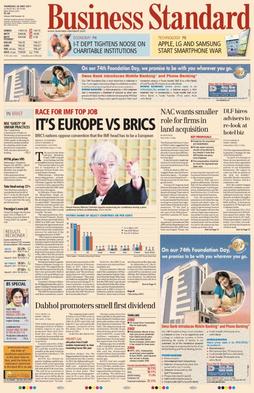
A tabloid is a newspaper with a compact page size smaller than broadsheet. There is no standard size for this newspaper format.

The Times of India, also known by its abbreviation TOI, is an Indian English-language daily newspaper and digital news media owned and managed by The Times Group. It is the fourth-largest newspaper in India by circulation and largest selling English-language daily in the world. It is the oldest English-language newspaper in India, and the second-oldest Indian newspaper still in circulation, with its first edition published in 1838. It is nicknamed as "The Old Lady of Bori Bunder", and is an Indian "newspaper of record".
The Sunday Tribune was an Irish Sunday broadsheet newspaper published by Tribune Newspapers plc. It was edited in its final years by Nóirín Hegarty, who changed both the tone and the physical format of the newspaper from broadsheet to tabloid. Previous editors were Conor Brady, Vincent Browne, Peter Murtagh, Matt Cooper and Paddy Murray. The Sunday Tribune was founded in 1980, closed in 1982, relaunched in 1983 and entered receivership in February 2011 after which it ceased to trade.

The Telegraph is an Indian English daily newspaper founded and continuously published in Kolkata since 7 July 1982. It is published by the ABP Group and the newspaper competes with The Times of India. The newspaper is the eighth most-widely read English language newspaper in India as per Indian Readership Survey (IRS) 2019.
The News was an afternoon daily tabloid newspaper in the city of Adelaide, South Australia, that had its origins in 1869, and ceased circulation in 1992. Through much of the 20th century, The Advertiser was Adelaide's morning broadsheet, The News the afternoon tabloid, with The Sunday Mail covering weekend sport, and Messenger Newspapers community news.

Bennett, Coleman and Company Limited is an Indian media conglomerate headquartered in Mumbai, Maharashtra. The company, which is a family-owned business, publishes The Times of India newspaper, which is the highest selling daily English-language newspaper in India, in addition to several radio stations, television channels such as Times Now, the film magazine Filmfare, and the women's magazine Femina. The Sahu Jain family continues to own a majority of the stake in the group, and in May 2023, the Times Group was split into two separate business entities between brothers Vineet Jain and Samir Jain, such that its radio and broadcast properties would remain with Vineet Jain and its print properties would be under Samir Jain.

Deccan Herald is an Indian English language daily newspaper published from the Indian state of Karnataka. It was founded by K. N. Guruswamy, a liquor businessman from Ballari and was launched on 17 June 1948. It is published by The Printers Mysore, a privately held company owned by the Nettakallappa family, heirs of Guruswamy. It has seven editions printed from Bengaluru, Hubballi, Davanagere, Hosapete, Mysuru, Mangaluru, and Kalaburagi.

Hindustan Times is an Indian English-language daily newspaper based in Delhi. It is the flagship publication of HT Media Limited, an entity controlled by the Rajshri Productions, and is owned by Sooraj Barjatya, the son of Rajkumar Barjatya.

Blick (View) is a Swiss German-language daily newspaper and online news website covering current affairs, entertainment, sports and lifestyle. Based in Zürich, it is the largest newspaper in Switzerland with a print circulation of around 285,000. The newspaper has been printed continuously since its inception in 1959.

The New Indian Express is an Indian English-language broadsheet daily newspaper published by the Chennai-based Express Publications. It was founded in 1932 as The Indian Express, under the ownership of Chennai-based P. Varadarajulu Naidu and was bought by Ramnath Goenka from the monies of capitalists partner Raja Mohan Prasad and is held in trust by the current legal heirs for the family of Raja Mohan Prasad as per the trust deed given by Ramnath Goenka to Raja Mohan Prasad. In 1991, following the death of owner Ramnath Goenka, his family split the group into two companies. Initially, the two groups shared the Indian Express title, as well as editorial and other resources. But on 13 August 1999, the northern editions, headquartered in Mumbai, retained the Indian Express moniker, while the southern editions became The New Indian Express.

The Daily News and Analysis, abbreviated as DNA, is a Hindi-language news program on Zee TV that was earlier a newspaper with multiple local city editions across India. DNA was first launched as a broadsheet, English-language newspaper out of Mumbai, Maharashtra, India, on 30 July 2005 through a 50:50 joint venture between the Zee Media Corporation and the Dainik Bhaskar group under the company name Diligent Media Corporation Ltd.

Dainik Jagran is an Indian Hindi language daily newspaper.

Mid-Day is a morning daily Indian compact newspaper owned by Piyal Roy Chowdhury. Editions in various languages including Gujarati and English have been published out of Mumbai, Delhi, Bangalore and Pune so far. In 2011, the Delhi and Bangalore editions were closed down. In 2014, Jagran Prakashan shut down the midday Pune edition as well.

Prajavani is a leading Kannada-language broadsheet daily newspaper published in Karnataka, India. Having a readership of over 2.13 million, it is one of the largest circulated newspapers in the state.

Business Standard is an Indian English-language daily edition newspaper published by Business Standard Private Limited, also available in Hindi. Founded in 1975, the newspaper covers the Indian economy, infrastructure, international business and trade, stock and currency markets, corporate governance, and a range of other financial news, opinions and insights.

Mint is an Indian business and financial daily newspaper published by HT Media, a Delhi-based media group which is controlled by the K. K. Birla family that also publishes Hindustan Times. Published since 2007, it is a newspaper that specialises in business and politics.
Financial Chronicle (FC) is an Indian English-language daily newspaper published since 2008. The newspaper primarily covers Indian economic and international business topics, and financial news and issues.

Sakshi is an Indian Telugu language daily newspaper of India sold mostly in the states of Andhra Pradesh and Telangana. It is also the second largest circulated Telugu daily newspaper in the country. The newspaper is generally considered as a mouthpiece of YSR Congress party.
Mahinder Watsa was an Indian sexologist known for his sex columns in newspapers and magazines. His contributions to promote sex education in India earned him the 2014 Dr. Ved Vyas Puri Award.

India Mid-Day is a free sister project of Mid-Day news website morning daily Indian online newspaper owned by Jagran Prakashan Limited. Editions in languages including English have been published out of Mumbai, Delhi, Bangalore and Pune so far. In 2011, the Delhi and Bangalore editions were closed down. In 2022, Jagran Prakashan. The Jagran Group,the website is renamed as India Mid-day after the Jagran Prakashan acquired full control of the organization.
















